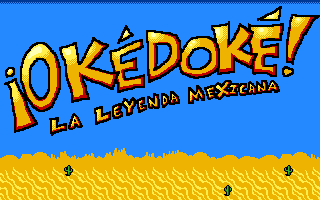

An Important Message:
Before I start discussing the game, I want to first discuss an important virus that’s invading pop culture. That virus is something we like to call “political correctness.” It’s a virus that if left untreated long enough can kill comedy. Dead. And once it’s dead, it’s too late to fix it.
In the early nineties, the media introduced “Political Correctness” to helpless victims across the world. Through this epidemic, black people became “African-Americans,” whether they were African, Haitian or English, and “black” became a bad word. The people we used to call “retarded,” have since been called “mentally challenged.” Even though they are still, by definition, “retarded,” political correctness tells us that we’re insensitive if we choose to use that word. And if we’re insensitive, we’re traitors to humanity and can no longer be used as political puppets.
Until these institutions told us what was considered insensitive, no one really had to be accountable to their words. If I told you to sit Indian-style in front of the TV, you’d curl up on the floor with both legs folded over your knees. Nowadays, “Indian-style” is an “insensitive word” (against “Native Americans”) that has been replaced with the intensely childish “crisscross applesauce,” which I would feel stupid to say to you if you were over the age of eight.
But “crisscross applesauce” is politically correct; and while it offends me to use it, it’s apparently non-offensive to Indians, who, last I checked, don’t really use it themselves.
So, what does that leave us with? Some unfunny comedy?
In 1998, a miracle happened. The world was given a wonderful tale of “Boy Meets Girl,” “Boy Gets Frank and Beans Stuck in Zipper,” “Boy Loses Girl,” in a comedy where the mentally challenged were exploited, private detectives had huge teeth, and no one was safe from ridicule. That movie was called There’s Something About Mary, and its amazing success proved once and for all that political correctness is just another tool the media uses for making people feel bad about themselves, and that audiences shouldn’t have to put up with it in their entertainment.
Eleven years later it seems that Dark Blubber, the creator of Okédoké! La Leyenda Mexicana, understood the importance of killing the virus of political correctness before it spread into his comedic tale, because if it had been given clearance to survive, we never would’ve fought the Mighty Racist Border Rangers or bought power-ups from Taco Bell, and where would that leave us Socially Challenged Caucasian-Americans?
The Game:

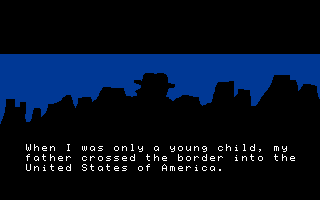
Originally
created for the 2009 8-Bit Contest, Okédoké!
La Leyenda Mexicana,
or Okédoké
for short, stunned the community with not only its near
flawless
graphic presentation (which resembled a beloved SNES classic called
Earthbound)
but also its super lengthy gameplay. And keep in mind that when I
say, “stunned the community,” I really mean,
“stunned me.” It
was long in adventure, full of rich characters, and even offered the
occasional puzzle. I downed several cups of coffee throughout the two
or three early mornings I spent playing it, and it just kept going.
For having spent only a month producing it, Dark Blubber really
crammed a brick-load of content and possibly solidified himself as
one of the community’s brightest new game designers.
For
the full account of my early impression, you can read my first review
of the game here.
It recounts the game in a bit more pointblank fashion than what I
plan to do for this review.
Now, as I said, I was stunned. Impressed. Flat out boggled by the presentation. And yet, I was tickled. It was like I was finally playing the game that The Adventures of Powerstick Man should’ve been, the game that I always intended it to be. It followed the exploits of a superhero, ravaged the nature of pop culture through no hold’s barred parody, and it succeeded at being a genuinely entertaining game. And it was done in a month, whereas Powerstick Man took me eight months. And both games had roughly an equal amount of playtime. It was a phenomenal experience to see what could be done in such little time.
Then
again, ten years later the OHR has to have games like this. With all
the tricks it can pull off now, there’s no excuse for Okédoké
to be any less impressive. And its above par, but below
excellent
Slime Salad rating proves that. Which means, despite how fun the game
was for me, I still have to rate it according to the standard that
designers are capable of these days.
So
from this point on, I will be reviewing the game chapter by chapter
(based on the bugfixed update released in early July), and will break
it up into three separate reviews.
This
month, obviously, will cover the first chapter. And because everyone
reading this will have likely played the first chapter by now (and
already voiced his opinion about the battles, and especially the
battles against the scorpions), I will instead use the first review
as a mission log for finding the elusive “Super
Boss” that Dark
Blubber said existed in the July version (which I actually
won’t
get to this month because it’s located in Chapter Two, which
I
didn’t have time to review).
So
with that, let us begin.
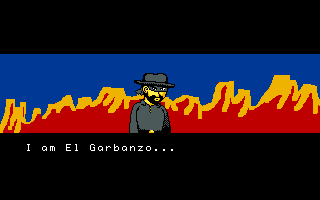
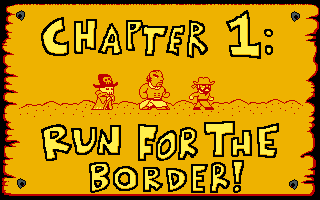
I began my quest in a town called El Pueblecito, wandering around and buying stuff, as one would expect to do in the beginning of an adventure like this. I spoke to goats, listened to children complain about their fathers refusing to sell them weapons, and bought tacos from a taco vendor.
Switch
to Reviewer Mode:
El Pueblecito was a tight-knit town full of sombrero wearing hippies who had goats, taco stands, and the occasional word of advice. The floors inside each house reminded me of old style Game Boy Color floors, and the ability to search drawers and sleep in beds for free was a nice touch.
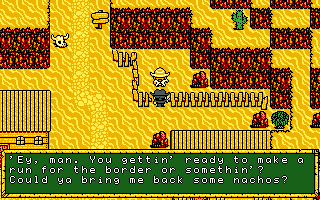
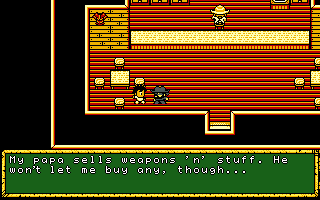
So
cruel. How does he expect you to defend yourself at school?
Switch
to Traveler Mode:
And then I set out for the mountain, heading first into a cave to steal the legendary 20 Pesos it hid in a treasure box.
It was in that cave that I fought my first battle. And won. And immediately returned home to sleep off my battle damage.
Switch
to Reviewer Mode:
In my first playthrough following the contest I actually had to run back to town and take naps all the time, revisiting as many as ten times or more just so I had the strength to make it to the top of the mountain without having to use up all my expensive restoration items. Fortunately, Dark Blubber addressed a number of pacing problems with battles and now I find it’s easier to get to the top and beyond without having to sacrifice a whole lot (including precious time).
Switch
to Traveler Mode:
The mountain path to the top was perilous, but fortunately I found help in the form of jalapeños and taquitos to keep me strong. I also found comfort in the revelation that enemies were easier to hit than they were the last time I took this journey pre-July.
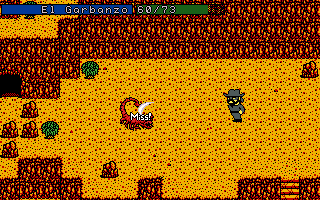
At the top of the mountain, I found a cave. And in that cave, I found spikes amidst the stalagmites. They weren’t painful to step on, mind you, but they irritated my feet a little. And they were everywhere. It was impossible to move down some paths without cutting across rows of them.
Switch to Reviewer Mode:
Every extensive cave throughout the game world has some area where spikes have to be tread upon in order to move forward. I wasn’t particularly annoyed by this convention, because it depleted very little energy. But I did find it strange that it offered you no alternative way around it.
I did like the cave graphics, though. Caves in general are tough to draw and I was especially impressed that Dark Blubber could develop a convincing cave with his limited palette. I also thought the caves brought out the feeling of exploration a little better than the mountain did.
He also rewards us with treasure boxes containing unpredictable items (or unpredictable until you open them) from large cash deposits to deadly scorpions.
Switch to Traveler Mode:
But one path I crossed brought me to a ladder, which led back down through the mountain, down into the red chambers of inner-Mexico, until I once again stumbled out into the sun, and into the realm of the dead, or Ghost Town as it’s called on Google Earth.
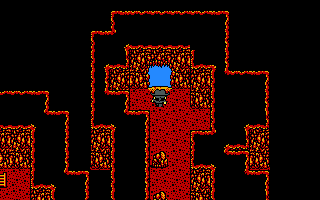
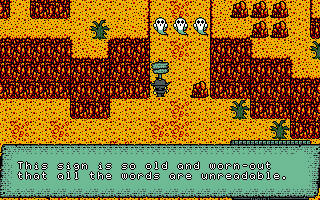
I traveled around a bit, hoping to talk to some interesting conversationalists. But all I found were dead people, and some painfully obvious ones at that.
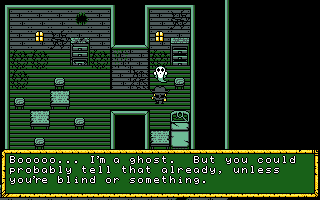
I
did manage to pillage the town for some gold and hefty sums of pesos.
But it left me with a hollow feeling that I could only fill by
raiding the local abandoned mine.
It was there that I encountered...him...
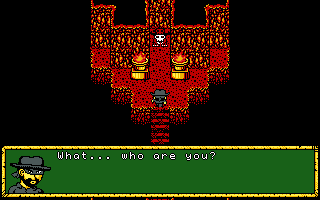
After already knowing my tale, he decided to join me on my quest to run for the border. But he wasn’t pleasant. And he smelled of death.
Switch to Reviewer Mode:
The thing I liked most about Ghost Town was its hybrid feeling of relief and dread when I’d walk around town. It was a relief to have a place to sleep after spending many steps fighting random enemies in caves and on the mountainside. But it was also dreadful, as sometimes the monsters would attack me after I climbed out of bed. And there were no restorative items for sale (that I found) nearby, so the journey constantly rode me on the edge of a seesaw.
I also thought Señor Death had one of the better entrances in recent OHR memory. Dark Blubber skillfully left me thinking that I was about to fight a boss, and then opened up the curtain and said “Boo! Here’s your first teammate.” It was brilliant.
Switch to Traveler Mode:
We left the mine and the ghost town, and headed for the other chambers of the mountain cave, looking for treasures to plunder. It was to the left that we caught a glimpse of our sun-baked future.
Though we were dizzyingly high on a dusty cliff, we could see the valley from there. And as a reward for our diligent travels, we liberated the contents of two treasure chests, one of which contained a nice, destructive stick of dynamite that some boss was asking for come the future. Then it was time to head back to El Pueblecito, stock up on new weapons and tacos, and to finally head through the scorching valley where we would make that run for the border.
The journey was far from easy, though. Distorted light glowed over the desert sand, sapping us of strength (yes, even the undead Señor Death was having issue), and scorpions and sunburned zombies rushed us from the stalks of cacti. But we pressed on until we reached the northern desert.
Then some fool tried to rob us, but we showed him.
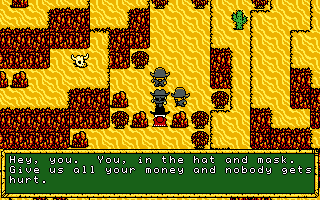
When
the thieves fled, we encountered a flatulent soul by the name of Sir
Rialgo, recruited him for the journey and continued on toward a
donkey ranch where we eventually sought passage to the border.
Switch
to Reviewer Mode:
The
desert between El Pueblecito and the Donkey Ranch is considerably
shorter than the mountain path and its adjacent locales. But the
reduced travel time is countered with tougher enemies, wide
dehydration zones, and a mini-boss fight. And as a bonus, the added
teammate, Sir Rialgo, is a heavier hitter than Señor Death,
causing longer battles to suddenly shrink.
So
kudos once again go to Dark Blubber’s ability to balance two
non-similar areas.
And
I know that some people had issue with the long donkey ride between
the ranch and the border, but I personally thought it was funny.
Switch
to Traveler Mode:
And then came the moment of truth when we actually reached the border. But little did we know, opposition would come in three different forms.
First, we had common guards blocking our paths. There was a tunnel that would permit us to bypass them. But whether we eluded the guards or fought them head on, it didn’t save us from an encounter with the most vile of all border patrol: The Mighty Racist Border Rangers.
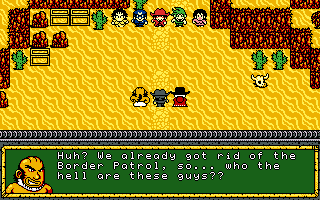
Defenders
of Voltron? With a ten gallon hat? Or maybe the cast of High
School Musical 4?
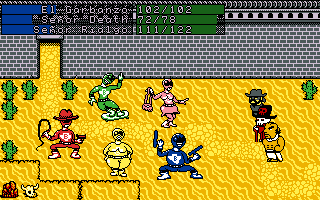
These
guys were powerful, but mortal. And we discovered that they possessed
a number of special items on their searchable bodies, including a
happy little vest called “Kevlar.” And the Kevlar
was priceless
because it made El Garbanzo several points tougher.
We also discovered that their bladders shrank if we happened to take down an F-15 before their very eyes.
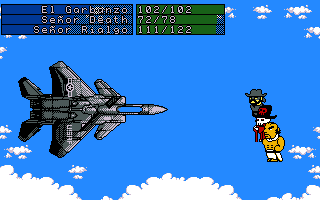
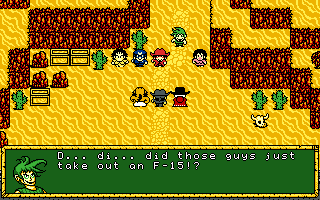
But once we showed them how little mercy we possessed, they got the hint and moved on. And so did we...
Into a place called “Wrongside.”
And we’ll pick up our journey from here next time.
Switch to Reviewer Mode:
The Mighty Racist Border Ranger battle is probably what made me such a fan of this game. Until this fight, I only marveled at the scale of the adventure. But with the diverse characterizations they brought to the stage, their strange battle techniques and hilarious encounter dialogue, I immediately saw this as one of the classics of 2009. Plus, any game that pulls off a brilliant parody wins top score from me. A number of crappy joke movies prove that it isn’t easy to do this, so when somebody does it, it deserves the accolade.
I also admire Dark Blubber’s “extra mile” technique that gave the player several options for tackling the border, and for having different responses to each choice.
Conclusion:
So that covers the opening chapter of the game and basic summation of my thoughts. Obviously I could get into more stuff, but it’s late, I have less than 15 minutes left in the month, and Surlaw is waiting for this article. Be happy if I even get a chance to revise it.
And stay tuned next month when we cover Chapters 2, 3, and preview 4.
Have a nice August.